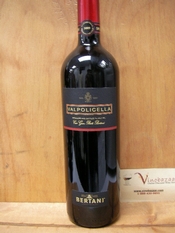First came the summer solstice and then the long Fourth of July weekend. There can be no more clinging to the cool breezes of spring. Summer has arrived, the sun is beating down, and I’ve had to scramble to the cellar to find an appropriate red wine because the lady of the house thought the red blend from the Napa Valley wasa bit too heavy for the moment.
Indeed, she was right. The bigger, richer reds I’ve been enjoying through winter and spring now seem heavy and ponderous, not a good fit for the summer table.
 I rummaged through a number of possibilities in the wine cellar before I settled upon a 2009 Bertani Valpolicella. This is a wine from northern Italy’s Veneto region, which encircles the romantic city of Verona, and it’s a first for this renowned producer of Amarone, the signature wine of the area.
I rummaged through a number of possibilities in the wine cellar before I settled upon a 2009 Bertani Valpolicella. This is a wine from northern Italy’s Veneto region, which encircles the romantic city of Verona, and it’s a first for this renowned producer of Amarone, the signature wine of the area.
Bertani has never before sold a Valpolicella in the United States, perhaps because the market here had been poisoned by thin, watery Valpolicella that was both acidic and uninteresting. In fact, Valpolicella is made from the same grape, Corvina, that produces the fabulous Amarone. Good Valpolicella can be quite intriguing, and it offers excellent value for the quality.
The 2009 Bertani Valpolicella had earned a silver medal at the 2010 Sommelier Challenge, where professional sommeliers from America’s leading restaurants evaluate the wines in a "blind" tasting format. It retails for $14.
I checked the alcohol by volume (ABV), which is printed in small type on the label, and was pleased to discover the ABV was a modest 12.5 percent; that’s a plus for a "summer" red. For the higher-alcohol wines, those in the 14.5 percent range and higher, seem to become more ponderous and less enjoyable as the mercury rises.
I pulled the cork and poured a splash. The nose exhibited plenty of rich dark fruit. There were hints of spice. It was off to a good start. Then I took the first sip and had a moment of doubt. There was quite a bit of bite on the finish, though I should have expected that because these wines do not lack for acidity, even when they have plenty of fleshy fruit.
The acid test came, literally, when I took the wine after a bite of food, which in this case was pasta in a light marinara sauce. The wine came alive. It was summer in a bottle, with gorgeous fruit and spice notes. I barely noticed the acidity that had been so apparent at first, except to note the clean finish. My Italian friends would have said "perfecto"!
So, now I am re-evaluating my stock of "summer" reds. I’ve decided I need more Beaujolais. The past two vintages, 2009 and 2010, have been spectacular, and the wines are still relatively cheap. An added bonus with Beaujolais is that it tastes so good when it’s chilled, which is the way to go when dining al fresco.
Chinon from France’s Loire Valley is another excellent summer wine for many of the same reasons that Valpolicella and Beaujolais work so well. It tends to be lower in alcohol, not terribly expensive, and it, too, tastes good when chilled. Chinon is made from the Cabernet Franc grape and is generally lighter in body than Cabernet Franc made in other parts of the world, so a straight trade of Chinon for Cab Franc may not work out for you.
Of course, there is the option of switching to crisp white wines and fruity rose wines during the hottest month of the year, though matching those wines with heartier summer fare, especially red meat, might prove challenging.
And there is no need. If you choose wisely, there is no reason that you can’t drink fabulous red wines all summer long.
8
